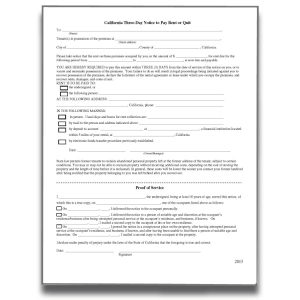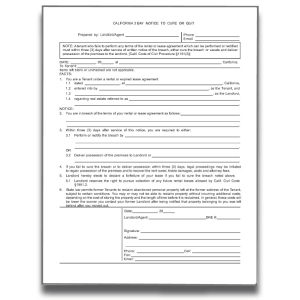California Eviction Process
The following describes the process for evicting a tenant in California known as an Unlawful Detainer Action. This information applies to residential rental property. It does not discuss evictions from commercial or agricultural property or those related to foreclosure proceedings.
1. Complete the proper notice. Depending on the circumstances, there are several types of notices a landlord can use to begin the eviction process. The following are a list of the types of notices:
- California 3 Day Notice to Pay or Quit (For failure to pay rent)
- California 3 Day Notice to Cure or Quit (For tenancy violations other than nonpayment that can be fixed)
- California 3 Day Notice to Quit (For incurable tenancy violations)
2. Serve the tenant and wait. A landlord may deliver the notice personally to the tenant at their residence or place of business. A landlord may also post it in a very conspicuous area where any reasonable person would discover it such as the front door (a copy should then also be sent by certified mail). Another option is to present the notice to an adult at the dwelling unit (a copy should then also be sent by certified mail).
Note: A landlord must allow an extra day if notice is not personally delivered to the tenant.
3. Lawsuit is filed. If the tenant fails to respond to the notice to quit the landlord may file an action with the county civil court where the rental property is located. The following free court forms will need to be filed along with the current required filing fee (usually a few hundred dollars):
4. Serve the tenant with notice of the lawsuit. The landlord must hire a process server to physically serve the tenant with a copy of the complaint and summons.
5. Wait for the tenant to answer. The tenant has five days to answer the court if they were served in person or fifteen days to respond from the date the summons was mailed. The tenant may answer using Form UD-105.
5. Ask for a default judgment. If the tenant fails to answer the court, the landlord may ask the judge for a default judgment for possession to be awarded. However, if the tenant does respond and disputes the claims made by the landlord, the judge will schedule a trial to hear from both sides. The following forms made by used by a landlord when seeking a default judgment:
- Request for Entry and Default Judgment (CIV-100)
- Judgment for Unlawful Detainer (UD-110)
- Writ of Possession (EJ-130)
6. Ask sheriff to execute judgment. Once the writ of possession has been approved by the court, the landlord may take it to the sheriff to seek their assistance in enforcing the landlord’s judgment for possession of the property.
Notice to Quit
A 3 Day Notice to Pay or Quit may be used when a tenant fails to pay rent according to the terms of the lease agreement. If the rent isn’t brought current within 3 days, the landlord may file an eviction lawsuit. CA Civ Pro Code § 1161(2)
-
Original price was: $12.95.$9.95Current price is: $9.95.
A 3 Day Notice to Cure or Quit may be used by a landlord for a material noncompliance of tenancy. The notice demands the violation be cured within 3 days or the tenant must vacate. CA Civ Pro Procedure §1161(3)
-
Original price was: $12.95.$9.95Current price is: $9.95.
A 3 Day Notice to Quit may be used by a landlord for any violation of tenancy deemed incurable. The notice demands the tenant vacate in 3 days because tenancy has been terminated. CA Civ Pro Procedure §1161(3)
-
Original price was: $12.95.$9.95Current price is: $9.95.
More California Eviction Information
- Summary Proceedings for Obtaining Possession of Real Property Calif. Civil Code 1159 – 1179a


